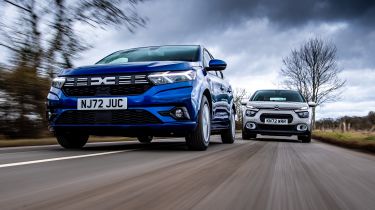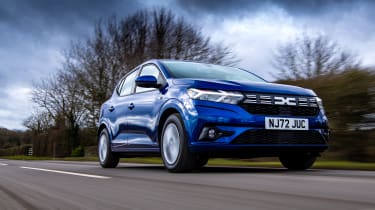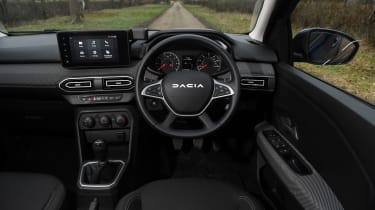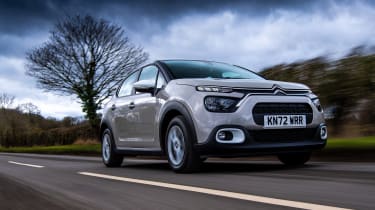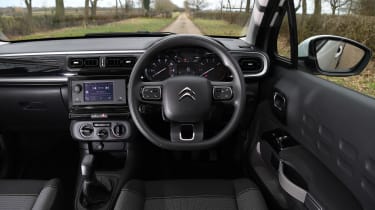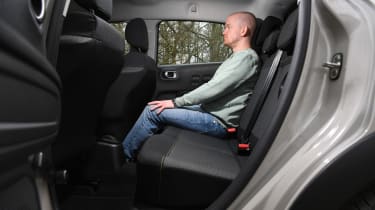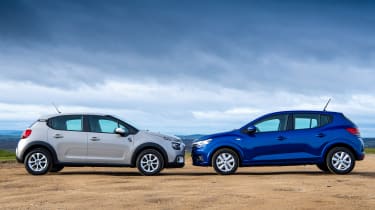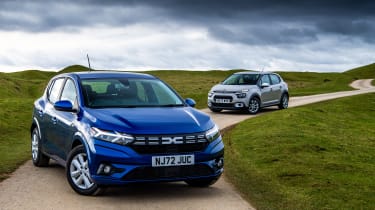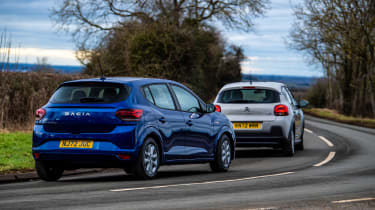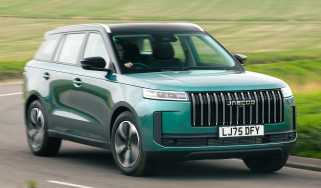Dacia Sandero vs Citroen C3: 2023 twin test review
We line up superminis from Dacia and Citroen in our head-to-head road test to find the best-value option
In the past, buying the cheapest new car on sale meant living with some trade-offs. Whether that was a wheezy engine, a cramped cabin or flimsy plastics, there was always an overriding feeling of compromise at every turn.
This pair shows that this no longer needs to be the case. Dacia has rebranded its range to steer away from its budget roots and towards a more rugged image. Here we’re trying the Sandero Expression, which costs £13,995.
Up against it is the Citroen C3 You! which is the same price, and almost £3,000 less than the next C3 in the range. Does it offer more for your money than the Sandero?
| Dacia Sandero 1.0 TCe Expression | Citroen C3 1.2 PureTech You! | |
| Price: | £13,995 | £13,995 |
| Powertrain: | 1.0-litre 3cyl turbo petrol, 89bhp, 5-spd manual, fwd | 1.2-litre 3cyl petrol, 82bhp, 5-spd manual, fwd |
| 0-62mph: | 12.2 seconds | 12.5 seconds |
| Test efficiency: | 49.3mpg/10.8mpl | 48.5mpg/10.7mpl |
| CO2: | 119g/km | 123g/km |
| Annual VED: | £165 | £165 |
Dacia Sandero
In Expression trim, the Dacia Sandero comes with a host of useful upgrades beyond the base Essential spec. On top of its £13,995 asking price, our test car is fitted with the optional Iron Blue paint (£650) and a spare wheel (£300), bringing the final total to £14,945.
Tech highlights
When the first-generation Sandero arrived, its low price was made possible by using Renault’s old platforms and tech. The latest model, however, is right up to date, using the same CMF-B underpinnings as the current Clio – our New Supermini of the Year for three years running.
To keep costs down, the Sandero misses out on some of the Clio’s creature comforts, though. While you can’t get the Renault’s hybrid option, you can get a few variants of its three-cylinder petrol engines. The turbocharged 1.0-litre unit we’re testing here comes with 89bhp and 160Nm of torque. It’s connected to a five-speed manual gearbox that sends drive to the front wheels. If you want a more rugged look for your Sandero, then the Stepway variant has a raised ride height and SUV-inspired body cladding.
Used - available now

2023 Tesla
Model Y Premium
52,159 milesAutomaticElectric
Cash £22,697
2024 Honda
HR-V Hybrid
22,177 milesAutomaticPetrol1.5L
Cash £21,997
2024 Toyota
Yaris Cross
9,761 milesAutomaticPetrol1.5L
Cash £21,897
2024 Volkswagen
Golf GTE
25,554 milesAutomaticPetrol1.4L
Cash £21,176Safety: One key area where the Sandero has compromised on the Clio’s kit, however, is in safety tech. Autonomous emergency braking is standard, but the system isn’t able to recognise pedestrians or other road users. There’s no lane-departure warning system, either. These changes contributed to a much less effective Euro NCAP score for the Dacia than its Renault relative. When the Sandero was tested in 2021, it scored a disappointing two stars, with its lowest score registering as 41 per cent in the vulnerable road users category.
On the road
Light, compact cars such as these are designed to excel in town driving, where tight turning circles and agile responses count for plenty. But both of these models measure roughly four metres long and weigh about a tonne, so when you choose to venture further on to the open road, their modest power outputs aren’t the hardship that you might expect.
Around town: Predictably, the Sandero is very easy to drive at low speeds. The steering is precise enough, which combined with a 10.5-metre turning circle (0.4 metres smaller than the C3’s), means twirling the Sandero into tight spaces is a doddle. The clutch pedal is a little spongy, but the gearshift is slick enough, and the three-cylinder engine doesn’t vibrate at idle as much as the C3’s. At low speeds, the ride can bounce slightly over rougher surfaces, though.
A & B-roads: These cars don’t need to be anything more than competent on these roads, and the Sandero achieves just that. Find a twisty section, and the Sandero corners neatly, with decent grip and only a small amount of body roll. While the performance figures aren’t anything special, the turbocharged engine pulls cleanly from low revs. There’s a little bit of fuss if you try to make the most of all of the performance, but the car’s acceleration is consistent from any revs.
Motorway: As the road opens out, the Sandero’s soft ride makes light work of larger bumps, and it’s a perfectly capable long-distance cruiser. Road noise is more audible than in the C3, as is the engine, which is a bit gruffer at a cruise, even though it’s more hushed at low speeds. The steering is a little more relaxed than in its rival, so fewer corrections are needed to maintain position in a lane.
Ownership
All new Dacias come with a three-year/60,000-mile warranty. That’s the same as Citroen’s, but the Sandero scores a point over its rival for roadside assistance; it has three years’ cover to the C3’s one.
Dacia’s performance in our 2022 Driver Power survey was poor, though. Of the 29 brands surveyed, it languished towards the bottom, in 27th. However, the spread of its cars in the overall rankings was mixed; the Duster finished an impressive 14th in the individual rankings, for example.
Buyers won’t expect the finest of materials in a car so cheap, but the Sandero at least makes some effort to hide its budget roots. While there are plenty of hard plastics – particularly around the gearlever and the door panels – the padded fabric that spans the dashboard helps to lift what would otherwise be a very large expanse of grey. The same squidgy material is used on the door armrests, too. We’re not sure about the white plastic finishes to the air vents, though; while they match the white exterior add-ons, they look a little unfinished.
Storage touches: Look beyond the Sandero’s dashboard appearance, and there is some evidence that Dacia has tried to make the car easier to live with every day. Beyond the predictable storage areas, which include a large smartphone cubby and a decent-sized glove compartment (albeit one that’s hogged by an enormous owner’s manual) the small fold-out bag hook in the passenger footwell is a clever touch. There are a further four bag hooks in the boot, too.
Isofix mounts make it possible to install a child seat. However, the thin fabric slots in the upholstery will make it tricky to hook the seat up correctly. While back-seat passengers don’t get their own USB ports, they are provided with a 12-volt socket, which could take a USB adapter if necessary. Those passengers only get tiny door pockets, but foot space under the front seats is great.
Practicality
Neither of these cars gives limo-like space, but both are well packaged considering their compact external dimensions. It’s the Sandero that manages to offer just a touch more room overall – both in the back seats and in the boot.
Rear space: Overall, the Sandero’s back seats are a comfy enough place to be. Headroom is decent – even for adults – and kneeroom is above average for a supermini. The central seat is soft, but is fairly narrow and perched quite high, so it’s only going to be acceptable for short trips.
Boot: At 328 litres, the Sandero’s boot volume beats its rival by a decent 28 litres. The 40:60 split seats fold almost flat, but leave a pronounced step in the load space; like this, the total volume grows to 1,108 litres. The boot lip is very slightly lower than the C3’s, but the exposed metal edge is likely to be scratched easily.
What to buy?
Which engine and trim we’d choose…
- Engines: There are three 1.0-litre turbo petrol engines offered. We’d go for the 90 TCe manual because it’s the cheapest; an auto gearbox adds £1,500, while the petrol/LPG Bi-Fuel variant costs £14,495.
- Trim: Of the two available, we’d go for the higher Expression. Based on a three-year PCP with a £1,500 deposit and 10,000-mile annual limit, there’s only £17 per month between the two.
- Options: There aren’t really any extras to add to the Sandero. If you want to properly squeeze the budget, then Glacier White is the only no-cost paint colour.
- Our choice: We’d pick the Sandero tested here, a 1.0 TCe 90 manual in Expression trim.
Citroen C3
The C3 You! starts from £13,995, and the model in our pictures has no optional extras at all. The Soft Sand metallic paint of our car is the standard colour.
Tech highlights
While other Stellantis superminis such as the Peugeot 208 and Vauxhall Corsa ride on the group’s most up-to-date CMP platform, the C3 uses the same PF1 architecture that, in previous forms, dates back to the original C3 from 2002.
The tech has been upgraded significantly since that first model, though. While there’s no scope for hybrid powertrains here, the C3 is available with petrol and diesel engines. More powerful turbocharged options are available higher up the range, but the You! features a 1.2-litre naturally aspirated petrol. As with the Dacia, the C3 has a five-speed manual gearbox and front-wheel drive.
Safety: When the C3 was safety tested by Euro NCAP back in 2017, it achieved a four-star rating. A score of 88 per cent in the adult occupant protection category was a strong result, although it’s worth highlighting that NCAP’s standards get more stringent every couple of years, so the C3 might not achieve the same result if it were tested today. Unlike the Sandero, the Citroen does get a lane-departure warning system as standard. Six airbags and an autonomous emergency braking system are also included.
On the road
The C3 is among the best-riding superminis on sale today, but in other key areas it can’t quite match the Dacia. It’s more refined in some instances, but less so in others, while its real-world performance falls a little short.
Around town: The C3 lacks two useful town-driving features that its rival gets as standard: a reversing camera and rear parking sensors. Although the C3 is small, it’s still fairly hard to define the exact edges of the back bumper when rolling into a space, so you have to be much more careful in tight spots.
On the plus side, the steering is even lighter than the Dacia’s, so it’s easy to move around town. The clutch is quite light but not too well defined, and when combined with the car’s lazy throttle response, it means that you quite often slip the clutch a little further than you might need to in the Sandero. Large tyre sidewalls and soft suspension mean that the C3’s ride is excellent, though.
A & B-roads: In this area, it’s not a lack of equipment that makes the C3 harder work than the Sandero, but the lack of a turbo. The result is less low-down torque than its rival; at 118Nm, the Citroen’s maximum is 42Nm lower, and you need to get to 2,750rpm to reach it. That’s 650rpm higher than the Sandero’s peak.
As a result, you’ll need more revs for decent progress and make more use of the gearbox. Unfortunately its shifts aren’t consistent in feel or weight from one ratio to another. The steering isn’t just light, but it gives minimal feedback, so the C3 isn’t much fun to drive on a country road.
Motorway: Wind noise is the overriding sensation when driving at speed, with plenty of rustle coming from the C3’s front end. That aside, the Citroen is a capable long-distance cruiser for its size. That soft ride works well, and the engine is fairly hushed, even though it’s pulling 3,500rpm at 70mph.
Those relatively high revs mean it doesn’t feel too breathless, either; only on very steep, lasting inclines will you feel the need to change down a gear.
Ownership
Citroen fared better than Dacia in the overall brand rankings of our Driver Power survey. A 13th-place finish puts the French manufacturer in the middle of the table, and is a definite improvement over what it has achieved in the past. The C3 was its best-ranked model, too, finishing an impressive 25th out of the 75 cars surveyed. It was also the third-best supermini overall behind the Toyota Yaris and the MINI Hatchback.
It’s a cheap car, but unlike budget models of previous years, the C3 doesn’t feel distressingly basic inside. Yes, there are some hard plastics in places, but the use of varying finishes on the dash and textured panels on the door cards adds a little tactile quality. The rotary air-conditioning controls feel flimsy next to the Sandero’s, though.
The rear doors aren’t the largest, but open just wide enough so that fitting a child seat shouldn’t be too tricky. The mounting points poke out slightly from beneath the seat bases – less fiddly than the Dacia’s, but we prefer the plastic housings some other family hatchbacks use. The centre seat is a little flatter than the Sandero’s, too, so it’s a little more comfortable for a third occupant in the back.
As with the Dacia, the C3 has a stop-start system to help save fuel when the car is stationary, but if it’s a cold day or the air-conditioning is working hard, then it’s less likely to activate.
Usability: There are some ergonomic flaws, sadly. We’re not big fans of the electric mirror controls. They’re mounted on the dash instead of the door as in many other cars, so you have to lean forward to adjust them, taking your eyes away from their normal view of the mirror.
The front cup-holders are shallow – much like the Sandero’s – but are so far forward that any medium-sized coffee cup wouldn’t squeeze into them below the dashboard.
Practicality
The C3 will be great for younger families and is average for the supermini segment. But in most areas it tends to fall a little short of the Dacia’s versatility.
Rear space: In every dimension, the C3 is ever-so-slightly more cramped than the Sandero. True, there’s not much in it – a disadvantage of just a few millimetres in terms of elbow, knee or head room, but it all adds up. The seat bases are quite low relative to the floor, too, which lifts your thighs away from them, which would be uncomfortable for taller occupants.
Boot: While the C3’s 300-litre boot is smaller than the Sandero’s, the main issue is the opening itself. The lip is quite high and the tailgate is rather narrow, which makes it harder to load larger items on board. Drop the back seats down and the overall volume comes to 992 litres, which is 116 litres less than its rival.
What to buy?
Which engine and trim we’d choose…
- Engines: The C3 You! is only available with a non-turbo petrol engine. For more power, an auto, or a torquey diesel, there’s a big jump in cost to other versions.
- Trim: For the £3,000-plus saving the You! offers over the rest of the C3 line-up, we can easily forgive the absence of some standard kit. It’s our pick of the range by some margin.
- Options: A range of colours and a contrast roof are the main C3 options. You’ll need to talk to your dealer to discuss the cost of fitting a spare wheel; a puncture repair kit is standard.
- Our choice: There’s just one version, so we’d pick a colour and try to add a spare wheel.
Results
Which car comes out on top?
Winner: Dacia Sandero
Dacia’s desire to take its image into a more desirable place hasn’t diluted the Sandero’s key strengths. Just as before, it remains something of an automotive bargain.
Even beside the C3 – hardly a pricey car – it holds an advantage when it comes to fuel economy, servicing costs and, most of all, the monthly payments on a typical finance deal. That it has marginally stronger performance, a bit more space inside and better tech means that, for the cash, it’s an incredibly tempting prospect.
| Pros | Cons |
| Tiny running costs | Feels more basic than C3 |
| Roomy boot | Bouncy ride on some roads |
| Decent in-car tech | Noisy engine |
Runner-up: Citroen C3
The C3 settles for second here, but the gap between these two is small, and there are still plenty of reasons to go for the Citroen. Key to its appeal is its comfort, which makes it a very relaxing car to live with, especially if you mainly stick to town journeys, where its relative lack of power isn’t an issue.
Even though it’s slightly pricier than the Sandero to run, it’s by far the cheapest C3 you can buy, and easily the most convincing model in the range.
| Pros | Cons |
| Ride and seat comfort | Higher costs than Dacia |
| Frugal fuel consumption | Sluggish performance |
| Funky interior design | No smartphone integration |
Rivals and other options
Dacia wins our twin test, but what else is out there?
- Same class: Renault Clio
- Same Money: Kia Picanto
- Used: MINI Cooper
- Used: Vauxhall Corsa
- Coming soon: Cupra Urban Rebel
The great debate
What the Auto Express test team would do…
Sean Carson, associate editor: “There’s plenty to think about when it comes to these two cars and their budget-minded focus. The Sandero’s price has crept up recently, but it’s still the best bargain supermini around. I love the no-nonsense approach, which is just as present in the Duster SUV and seven-seat Jogger as it is here. We can only hope that Dacia’s lifestyle brand ambitions don’t dilute its budget angle.”
John McIlroy, deputy editor: “While we agree that the Dacia is the better car overall, the C3’s character certainly draws me in. The stylish looks stick out beside the straight-laced Dacia, and in a time where so many cars try too hard to be sporty, I love the C3’s softer approach to its style and on-road manners.”
Dean Gibson, senior test editor: "I understand why many buyers would like the extra kit that the Sandero Expression comes with over the Essential. But if it was my cash, I’d save a grand and go for base spec. I can do without body-coloured door mirrors and electric rear windows, and there’s a cradle to hold my smartphone anyway".
Steve Fowler, editor-in-chief: "Small cars tend not to be driven far, so why not go for a used EV? For the 14 grand mark, an electric car would bring tiny running costs and darty responses in town. The classifieds show plenty of Nissan Leafs on the market – or you could go for the quirky yet fascinating BMW i3."
Dawn Grant, picture editor: "If you need a little more space than the C3 or the Sandero can offer, but you still admire the Citroen’s charm, then I’d suggest a C3 Aircross instead. I ran the supermini-SUV as a fleet car back in 2018 and it was great. It proved to be a comfortable and practical family car."
What would you do? Let us know in the comments section below…
Specs and prices
| Dacia Sandero 1.0 TCe Expression | Citroen C3 You! | |
| On the road price/total as tested | £ 13,995/£ 14,945 | 13995/£13,995 |
| Residual value (after 3yrs/36,000) | £ 7,750/55.4% | 7450/53.2% |
| Depreciation | £6,245 | £6,545 |
| Annual tax liability std/higher rate | £770/£ 1,540.0 | 797.5/1595 |
| Annual fuel cost (10k/20k miles) | £ 1,370/£ 2,741 | 1393/£2,786 |
| Ins. group/quote/VED | 11/£454/£165 | 14/£548/£165 |
| Service costs (3 years) | £486 | £655 |
| Length/wheelbase | 4,088/2,604mm | 3,996/2,539mm |
| Height/width | 1,499/1,848mm | 1,474/1,829mm |
| Engine | 3cyl in/999cc | 3cyl in/1,199cc |
| Peak power/revs | 89/4,600bhp/rpm | 82/5,750 bhp/rpm |
| Peak torque/revs | 160/2,100Nm/rpm | 118/2,750 Nm/rpm |
| Transmission | 5-spd man/fwd | 5-spd man/fwd |
| Fuel tank capacity/spare wheel | 50 litres/£300 | 45 litres/dealer-fit option |
| Boot capacity (seats up/down) | 328/1,108 litres | 300/992 litres |
| Kerbweight/payload/towing weight | 1,072/490/1,100kg | 980/560/450kg |
| Turning circle | 10.5 metres | 10.9 metres |
| Basic warranty/recovery | 3 yrs (60,000)/3 yrs | 3 yrs (60,000)/1 yr |
| Driver Power manufacturer position | 27th | 13th |
| Euro NCAP: Adult/child/ped./assist/stars | 70/72/41/42/2 (2021) | 88/83/59/58/4 (2017) |
| 0-62mph/top speed | 12.2 secs/109mph | 12.5 secs/103mph |
| Auto Express economy/range | 49.3/542 | 48.5/480 |
| WLTP combined | 53.3mpg | 51.4mpg |
| WLTP combined | 11.7mpl | 11.3mpl |
| Actual/claimed CO2 | 132/119g/km | 135/123g/km |
| Airbags/Isofix/parking sensors/camera | Six/yes/r/yes | Six/yes/no/no |
| Auto box/lane keep/blindspot/AEB | £1,500/no/no/yes | No/yes/no/yes |
| Climate ctrl/cruise/leather/heated seats | Air con/yes/no/no | Air con/yes/no/no |
| Met paint/LED lights/keyless entry & go/pwr tailgate | £650/no/no/no | £545/yes/no/no |
| Sat-nav/digital dash/DAB/connected services | No/no/yes/** | No/no/yes/** |
| Wireless charging/Apple CarPlay/Android Auto | No/yes/yes | No/no/no |
